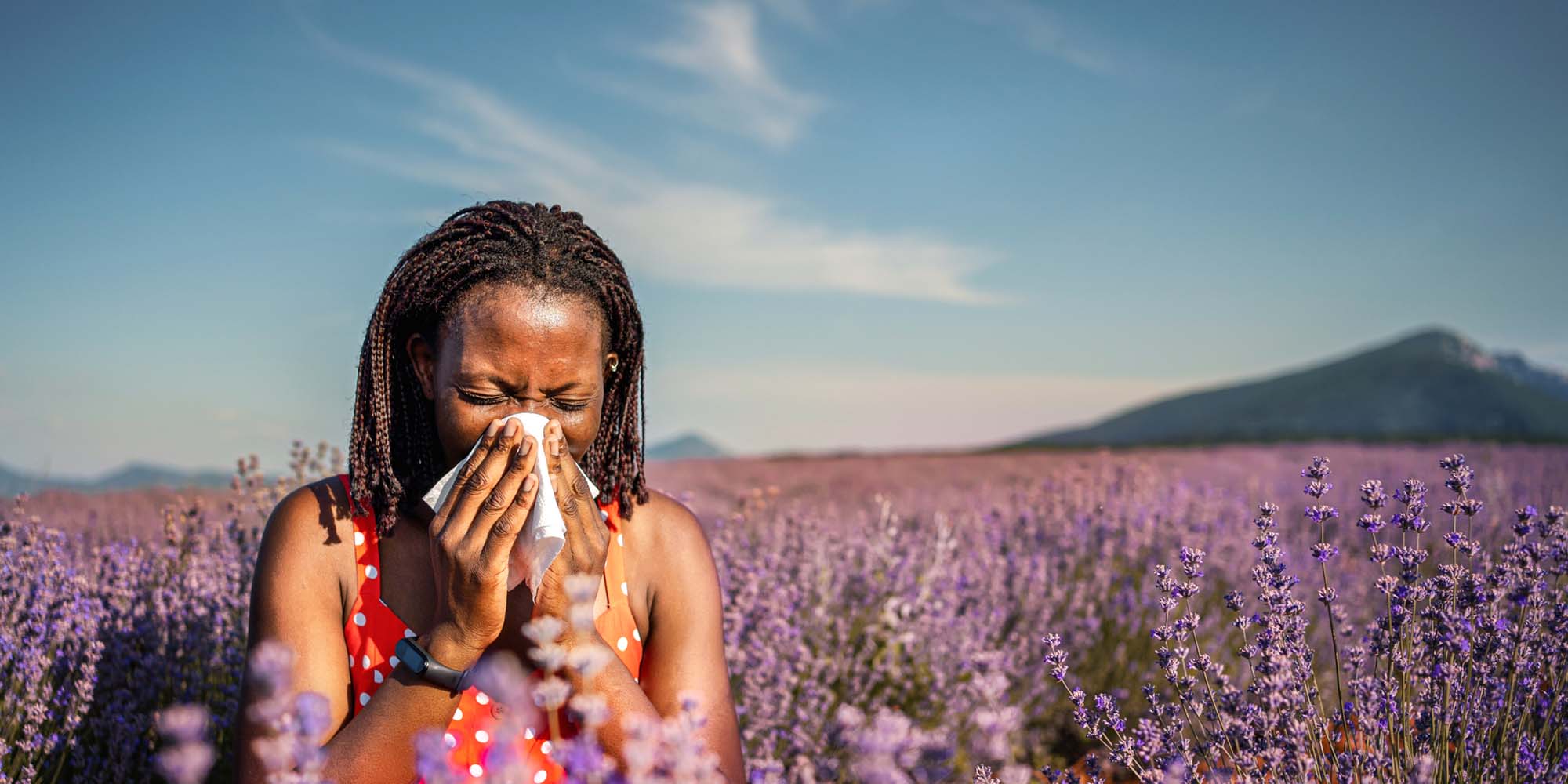Seasonal Allergy Relief: Expert Advice and Practical Tips to Breathe Easier
April 28, 2024
Categories: Allergy & Immunology, Health & Wellness
Tags: allergies
As the seasons change, so does the air around us, bringing with it a wave of seasonal allergies that affect millions each year. If you're among those who dread the arrival of spring or fall due to the sneezes, sniffles, and itchy eyes, you're not alone. While beautiful weather is on the horizon, seasonal allergies can put a significant damper on enjoying your time spent outdoors.

We spoke with Monica Patadia, MD, an ENT surgeon at Loyola Medicine, to help patients learn more about treating seasonal allergies with expert advice and practical tips.
"There are certain seasons when allergies start back up again for many people. Unfortunately, many people suffer without finding proper treatment. That doesn't need to be the case," says Dr. Patadia.
Understanding seasonal allergies
Seasonal allergies, commonly known as hay fever, are the immune system's overreaction to outdoor allergens like pollen from trees, grasses, and weeds. When these seemingly harmless particles enter our bodies, they trigger an immune response, leading to symptoms of sneezing, itching, and congestion.
"Essentially, allergies are an abnormal response to something that's normally in the environment. Our bodies go into hyper drive and react to things that maybe we should not react to; that's what allergies are," says Dr. Patadia.
Why do allergic reactions occur?
Genetics play a significant role—if allergies run in your family, you're more likely to suffer from them, too. Environmental factors also play a role, with changes in weather and pollution levels influencing the severity and onset of symptoms.
Understanding the root causes of these allergies is the first step toward managing them effectively. By identifying specific triggers and how they interact with your body, you can adopt more targeted approaches to mitigate their impact.
"Unfortunately, we don't know why different patients' immune systems respond to one thing or to the other. For some individuals, we know it's more familial; if one family member or two family members had the allergies you're more likely to have allergies," says Dr. Patadia.
Innovative treatment options for seasonal allergies
Seeking a doctor's advice is crucial for anyone struggling with allergies. A health care provider can confirm whether your symptoms are indeed allergy-related and help you explore treatment options. Over-the-counter remedies like antihistamines and nasal sprays can provide immediate relief, but for long-term management, other treatments might be necessary.
"The reason to come see a medical professional is if you have prolonged, severe symptoms that are not responsive to traditional store-bought medications. Your doctor can confirm your allergies and then provide an individualized plan," says Dr. Patadia.
One proven treatment is immunotherapy, which exposes your body to small amounts of allergens over time, reducing your sensitivity. Traditionally, immunotherapy is delivered through weekly allergy shots over a period of months or even years. However, sublingual immunotherapy offers a needle-free alternative. This method involves placing drops containing allergen extracts under the tongue, where they dissolve and are absorbed by the body. It's an especially appealing option for those who are needle-shy, for young children who might have difficulty with shots, or those who don't have time to make weekly doctor's appointments.
"Sublingual drops are a really unique option because with sublingual immunotherapy patients can give themselves drops under the tongue at home. It's actually thought to be safer than shots and still very effective," says Dr. Patadia.
Practical tips for reducing exposure to seasonal allergens
Reducing your exposure to allergens can significantly alleviate symptoms. Indoors, use air purifiers to clean the air of particles, and vacuum regularly with a HEPA filter to trap allergens. Keeping windows closed during peak pollen times can also help keep these irritants at bay. One solution that requires more work is replacing any carpet you have, which can trap allergens, with hardwood floors to reduce the amount of dust mites.
Outdoors, it’s wise to limit your exposure on high pollen days. Pollen forecasts can usually be found on weather websites, helping you plan activities when levels are lower. Pollen counts tend to be highest in the morning and late afternoon. You can also check the pollen count from Loyola Medicine on a daily basis starting in April of each year.
Wearing sunglasses can protect your eyes from pollen, and changing clothes after being outdoors can prevent pollen from spreading inside your home and creating an allergic reaction.
Allergens also vary throughout the year depending on the season and the geographic region.
Spring allergens
- Tree pollen: Spring is notorious for high levels of tree pollen, which is one of the first major triggers for seasonal allergy sufferers. Common culprits include oak, birch, cedar, elm, and maple trees. As temperatures rise, these trees begin to release pollen into the air, often starting as early as February in some areas and lasting until late spring.
Summer allergens
- Grass pollen: During the late spring and early summer, grasses start to produce pollen. This is a significant source of allergies and can include varieties such as Timothy, Johnson, Bermuda, bluegrass, orchard, and rye. Grass pollen levels can peak during warm, sunny, and windy days, typically in late May through July.
- Weed pollen: Weeds begin to pollinate in late spring but are most problematic in late summer, especially ragweed, which is one of the most common weed allergens. Other weeds include sagebrush, pigweed, and lamb's quarters. Weed pollen can continue to be a problem into the fall.
Fall allergens
- Weed pollen (continued): Ragweed continues to be a significant problem in many areas, with a single plant capable of producing up to a billion grains of pollen per season. This can travel long distances and is a common cause of hay fever.
- Mold spores: Fallen leaves and other damp organic materials can be breeding grounds for molds, which release spores into the air that can trigger allergy symptoms. Mold can be found both outdoors in piles of decaying foliage and indoors in damp areas.
Winter allergens
- Indoor allergens: With colder weather, people spend more time indoors where allergens like dust mites, pet dander, and indoor molds can be prevalent. Dust mites thrive in warm, humid environments and are commonly found in bedding, upholstered furniture, and carpets. Pet dander from animals such as cats and dogs can also cause year-round allergies but may be more noticeable in winter when homes are sealed up.
It's important to note that the timing and prevalence of these allergens can vary significantly based on local climate, weather patterns, and geographic location. For example, in warmer climates, some plants may pollinate year-round, and in colder regions, the growing seasons (and thus the allergy seasons) may be shorter.
Manage seasonal allergy symptoms with natural remedies and lifestyle adjustments
In addition to medical treatments, certain lifestyle changes and natural remedies can help manage seasonal allergy symptoms. Dietary adjustments, such as incorporating anti-inflammatory foods rich in omega-3 fatty acids, can support overall health and potentially reduce allergic reactions. Staying hydrated helps keep the mucous membranes moist, making it easier to clear allergens from the nose and throat.
Finally, stress management plays a subtle yet significant role in allergy management. High stress levels can exacerbate symptoms, so incorporating stress-reduction techniques like meditation, yoga, or deep-breathing exercises can be beneficial.
Dr. Patadia is a Chicago native who is fellowship trained in sinus surgery, allergy and facial plastics. She is involved on a city-wide and national level in ENT societies helping impact care and guidelines. She sees patients for a variety of allergy and sinus concerns, including revision and complex nasal procedures.
Book an appointment today to see Dr. Patadia by calling Loyola Medicine Burr Ridge at 708-327-1036.
